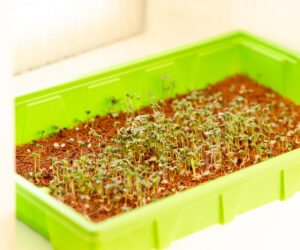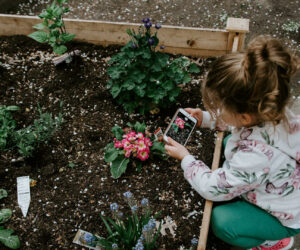Growing your own indoors
Growing your own indoors
Are you looking into growing your own indoors rather than out? It’s so rewarding to bring fresh, home-grown produce to the table. And our tips and hacks will help do this. Even when you don’t have outdoor space!
Why grow herbs and vegetables indoors?
From the second a plant is harvested, the picked produce starts to lose its nutritional value. In fact, a Penn State University research study discovered spinach loses much of its nutrient content after 8 days, even if it’s refrigerated. Add the carbon footprint of transporting fruit, vegetable and herbs, and it makes total sense to grow your own.
Vegetables you can grow indoors
Most vegetables thrive in sunlight, which is 9 times weaker indoors, even by a window. (Source: Engineering Toolbox) So make sure you pick varieties that can tolerate lower light levels. These can include:
Carrots
If you choose shorter carrot varieties, you only need a pot which is 30cm deep. You could even harvest baby carrots if you’re feeling impatient!
Garlic greens or scapes
Whoever had the light-bulb moment to not grow garlic just for the bulb is a genius! The tender garlic stems taste like a delicious cross between garlic and onion.
Micro tomatoes
Desperate for tomatoes? Try popping a micro tomato plant in as large a pot as you can manage. It will need as much light as possible too.
Peas
Non-vining snap peas or bush peas can provide you with delicious edible pea shoots, flowers and pods. They look really pretty too, giving a flourish to any meal.
Salad greens
Treat yourself to arugula, kale, chard, spinach, lettuce – iceberg, romaine, red leaf – and sorrel. These are usually ready for harvesting in just 4 – 6 weeks. If you’re clever enough to sow some every fortnight, you will end up with endless tasty ‘power greens’ for the table!
Spring radishes
These only take 4 weeks to grow from planting. You just need a shallow container of compost.
Grow your own microgreens
Do you love to add a ‘cheffy’ flourish to your dishes? Greenery boosts flavour, vitamins, and texture. A burst of colour against the more neutral-toned protein on your plate makes a meal more visually appealing too.
Microgreens are so easy to grow indoors. The principle is to harvest traditional plants way earlier than normal – before they grow a root system. This intensifies the flavour, giving a real kick to your recipes. Plus microgreens pack up to 40% more micronutrients compared to the fully-grown version!
Why not experiment with plants such as:
• Beet
• Brussel sprouts – but just for the stalks!
• Cucumber
• Kale
• Melon
• Radish
• Swiss chard
• Watercress
For more inspo, check out the Most Popular Microgreens for Chefs.
Types of herbs to grow indoors
Herbs offer a bouquet of tastes for your cocktails, tisanes and soups. Here are some varieties you can grow indoors:
• Chives – you can grow these indoors, if they’re in a deep container,
• Mint – there are so many amazing varieties of mint, including those with a hint of banana, grapefruit and even chocolate! But mint can run riot, so keep it separate in its own container.
• Rosemary – save time and money by growing rosemary from a cutting!
• Parsley – but she be hungry, so make sure you use compost with lots of integrated nutrients
• Sage – this needs to be protected from the cold, so make sure it’s in a warm spot
• Thyme – like mint, thyme can spread like wildfire so is best grown contained in its own pot. Seeds can be tricky, so we’d recommend sourcing a pre-grown plant from a garden centre or friendly gardener.
Grow your own herbs kit – microgreens too!
Want to grow your own herbs with the minimum amount of hassle? Our Grow Your Own Microgreens Kit includes 3 coir growing mats, a propagator, lid and tray. There’s even a pack of microgreen seeds if you want to give them a go. Just spray with water once a day once you’ve planted your seeds.
Pro Tip: If you’re growing herbs, choose the varieties that play well with others and are easy to grow from seed.
Indoor gardening supplies
• Pruners to snip – even a pair of scissors dedicated to your plants will do
• Indoor watering can – one with a long, narrow spout really helps when reaching plants at the back of a collection of pots
• Mister or spray bottle – delicate seedlings can be flattened if you douse them in water. Misting is a gentler way to keep them hydrated.
• Pot tray – when water drains from a pot, where does it go? Standing pots on a tray catches the run-off, as well as any dislodged compost.
• Sensors – electronic sensors help you keep an eye on temperature, humidity, soil acidity pH and light levels.
Compost that can be stored indoors
Indoor gardeners often don’t have the luxury of a storage shed or garage to stash their supplies. So how about ordering compost which can be easily be kept inside?
One of the many advantages of coco coir compost is that is already compressed when you buy it. No huge bags of compost to lug around with us! When you need compost for your plants, you just add water and fluff it up. Simple. It’s also:
• A natural by-product
• Excellent at retaining and releasing water
• Has anti-fungal properties and is resistant to mould
As you don’t dampen it until you need it, coco coir blends are easy to store inside. One of our team stores a box of our compost in her kitchen cupboard next to the tea bags! Curious? Take a look at our peat-free compost range.
Tips from the ‘Green Gardeners Guild’ online advice library
Love to see more tips and hints? Our blogs are packed with advice:
• How to prepare coco coir: garden use vs indoor plants
• What herbs are good to plant in autumn?
• How to start a vegetable patch
Growing your own indoors? Tag us in!
Are you enjoying produce from your indoor garden grown in our compost? Share your photos and tag @cocoandcoir on Instagram. We’ll credit you for any images we use and you’ll also be in with a chance to win some Coco & Coir goodies for your sustainable garden.













